The Role of the Kidney in Homeostasis and Osmoregulation
VerifiedAdded on 2022/08/19
|5
|1039
|23
Report
AI Summary
This report examines the kidney's pivotal role in maintaining homeostasis within the human body, focusing on urine formation and osmoregulation. Part 1 details the processes of urine formation, including ultrafiltration in the glomerulus, selective reabsorption in the renal tubules, and secretion. Part 2 explores the role of Anti-diuretic hormone (ADH) in osmoregulation, explaining its release from the posterior pituitary gland in response to blood water imbalance. The report describes how ADH increases the permeability of the distal convoluted tubule, enhancing water reabsorption and regulating the body's water balance, highlighting the kidney's critical function in waste excretion and maintaining internal equilibrium.
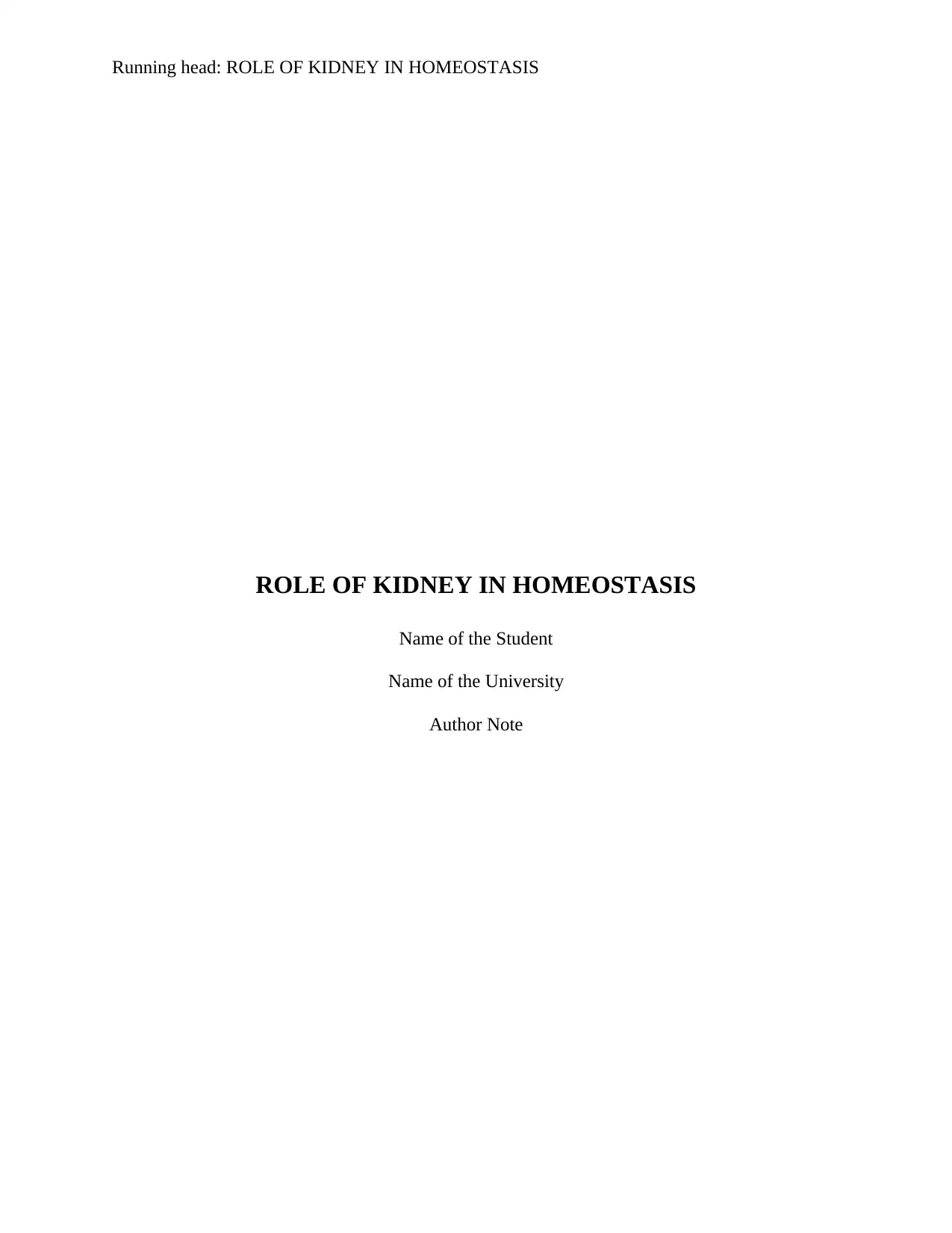
Running head: ROLE OF KIDNEY IN HOMEOSTASIS
ROLE OF KIDNEY IN HOMEOSTASIS
Name of the Student
Name of the University
Author Note
ROLE OF KIDNEY IN HOMEOSTASIS
Name of the Student
Name of the University
Author Note
Paraphrase This Document
Need a fresh take? Get an instant paraphrase of this document with our AI Paraphraser
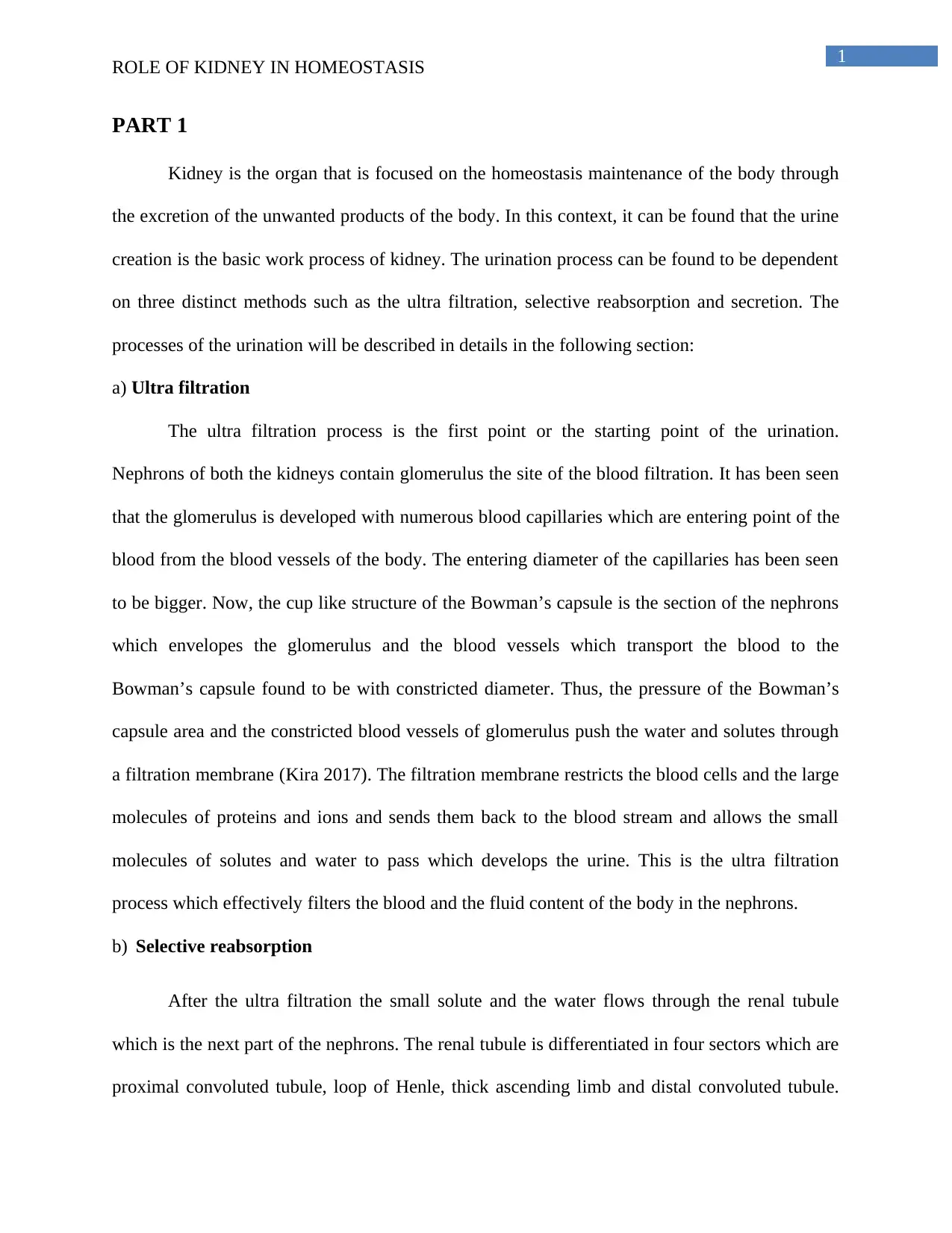
1
ROLE OF KIDNEY IN HOMEOSTASIS
PART 1
Kidney is the organ that is focused on the homeostasis maintenance of the body through
the excretion of the unwanted products of the body. In this context, it can be found that the urine
creation is the basic work process of kidney. The urination process can be found to be dependent
on three distinct methods such as the ultra filtration, selective reabsorption and secretion. The
processes of the urination will be described in details in the following section:
a) Ultra filtration
The ultra filtration process is the first point or the starting point of the urination.
Nephrons of both the kidneys contain glomerulus the site of the blood filtration. It has been seen
that the glomerulus is developed with numerous blood capillaries which are entering point of the
blood from the blood vessels of the body. The entering diameter of the capillaries has been seen
to be bigger. Now, the cup like structure of the Bowman’s capsule is the section of the nephrons
which envelopes the glomerulus and the blood vessels which transport the blood to the
Bowman’s capsule found to be with constricted diameter. Thus, the pressure of the Bowman’s
capsule area and the constricted blood vessels of glomerulus push the water and solutes through
a filtration membrane (Kira 2017). The filtration membrane restricts the blood cells and the large
molecules of proteins and ions and sends them back to the blood stream and allows the small
molecules of solutes and water to pass which develops the urine. This is the ultra filtration
process which effectively filters the blood and the fluid content of the body in the nephrons.
b) Selective reabsorption
After the ultra filtration the small solute and the water flows through the renal tubule
which is the next part of the nephrons. The renal tubule is differentiated in four sectors which are
proximal convoluted tubule, loop of Henle, thick ascending limb and distal convoluted tubule.
ROLE OF KIDNEY IN HOMEOSTASIS
PART 1
Kidney is the organ that is focused on the homeostasis maintenance of the body through
the excretion of the unwanted products of the body. In this context, it can be found that the urine
creation is the basic work process of kidney. The urination process can be found to be dependent
on three distinct methods such as the ultra filtration, selective reabsorption and secretion. The
processes of the urination will be described in details in the following section:
a) Ultra filtration
The ultra filtration process is the first point or the starting point of the urination.
Nephrons of both the kidneys contain glomerulus the site of the blood filtration. It has been seen
that the glomerulus is developed with numerous blood capillaries which are entering point of the
blood from the blood vessels of the body. The entering diameter of the capillaries has been seen
to be bigger. Now, the cup like structure of the Bowman’s capsule is the section of the nephrons
which envelopes the glomerulus and the blood vessels which transport the blood to the
Bowman’s capsule found to be with constricted diameter. Thus, the pressure of the Bowman’s
capsule area and the constricted blood vessels of glomerulus push the water and solutes through
a filtration membrane (Kira 2017). The filtration membrane restricts the blood cells and the large
molecules of proteins and ions and sends them back to the blood stream and allows the small
molecules of solutes and water to pass which develops the urine. This is the ultra filtration
process which effectively filters the blood and the fluid content of the body in the nephrons.
b) Selective reabsorption
After the ultra filtration the small solute and the water flows through the renal tubule
which is the next part of the nephrons. The renal tubule is differentiated in four sectors which are
proximal convoluted tubule, loop of Henle, thick ascending limb and distal convoluted tubule.
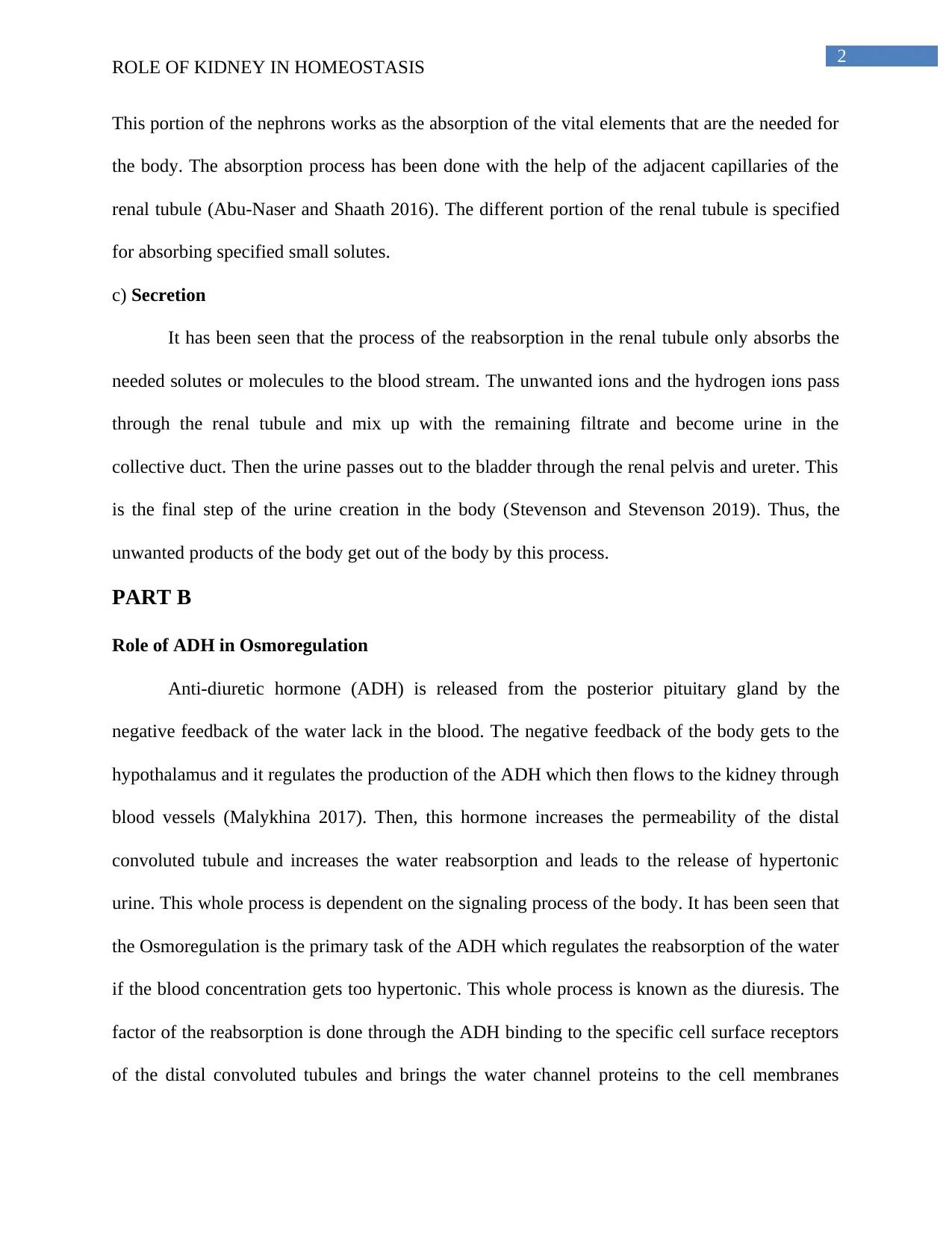
2
ROLE OF KIDNEY IN HOMEOSTASIS
This portion of the nephrons works as the absorption of the vital elements that are the needed for
the body. The absorption process has been done with the help of the adjacent capillaries of the
renal tubule (Abu-Naser and Shaath 2016). The different portion of the renal tubule is specified
for absorbing specified small solutes.
c) Secretion
It has been seen that the process of the reabsorption in the renal tubule only absorbs the
needed solutes or molecules to the blood stream. The unwanted ions and the hydrogen ions pass
through the renal tubule and mix up with the remaining filtrate and become urine in the
collective duct. Then the urine passes out to the bladder through the renal pelvis and ureter. This
is the final step of the urine creation in the body (Stevenson and Stevenson 2019). Thus, the
unwanted products of the body get out of the body by this process.
PART B
Role of ADH in Osmoregulation
Anti-diuretic hormone (ADH) is released from the posterior pituitary gland by the
negative feedback of the water lack in the blood. The negative feedback of the body gets to the
hypothalamus and it regulates the production of the ADH which then flows to the kidney through
blood vessels (Malykhina 2017). Then, this hormone increases the permeability of the distal
convoluted tubule and increases the water reabsorption and leads to the release of hypertonic
urine. This whole process is dependent on the signaling process of the body. It has been seen that
the Osmoregulation is the primary task of the ADH which regulates the reabsorption of the water
if the blood concentration gets too hypertonic. This whole process is known as the diuresis. The
factor of the reabsorption is done through the ADH binding to the specific cell surface receptors
of the distal convoluted tubules and brings the water channel proteins to the cell membranes
ROLE OF KIDNEY IN HOMEOSTASIS
This portion of the nephrons works as the absorption of the vital elements that are the needed for
the body. The absorption process has been done with the help of the adjacent capillaries of the
renal tubule (Abu-Naser and Shaath 2016). The different portion of the renal tubule is specified
for absorbing specified small solutes.
c) Secretion
It has been seen that the process of the reabsorption in the renal tubule only absorbs the
needed solutes or molecules to the blood stream. The unwanted ions and the hydrogen ions pass
through the renal tubule and mix up with the remaining filtrate and become urine in the
collective duct. Then the urine passes out to the bladder through the renal pelvis and ureter. This
is the final step of the urine creation in the body (Stevenson and Stevenson 2019). Thus, the
unwanted products of the body get out of the body by this process.
PART B
Role of ADH in Osmoregulation
Anti-diuretic hormone (ADH) is released from the posterior pituitary gland by the
negative feedback of the water lack in the blood. The negative feedback of the body gets to the
hypothalamus and it regulates the production of the ADH which then flows to the kidney through
blood vessels (Malykhina 2017). Then, this hormone increases the permeability of the distal
convoluted tubule and increases the water reabsorption and leads to the release of hypertonic
urine. This whole process is dependent on the signaling process of the body. It has been seen that
the Osmoregulation is the primary task of the ADH which regulates the reabsorption of the water
if the blood concentration gets too hypertonic. This whole process is known as the diuresis. The
factor of the reabsorption is done through the ADH binding to the specific cell surface receptors
of the distal convoluted tubules and brings the water channel proteins to the cell membranes
⊘ This is a preview!⊘
Do you want full access?
Subscribe today to unlock all pages.

Trusted by 1+ million students worldwide
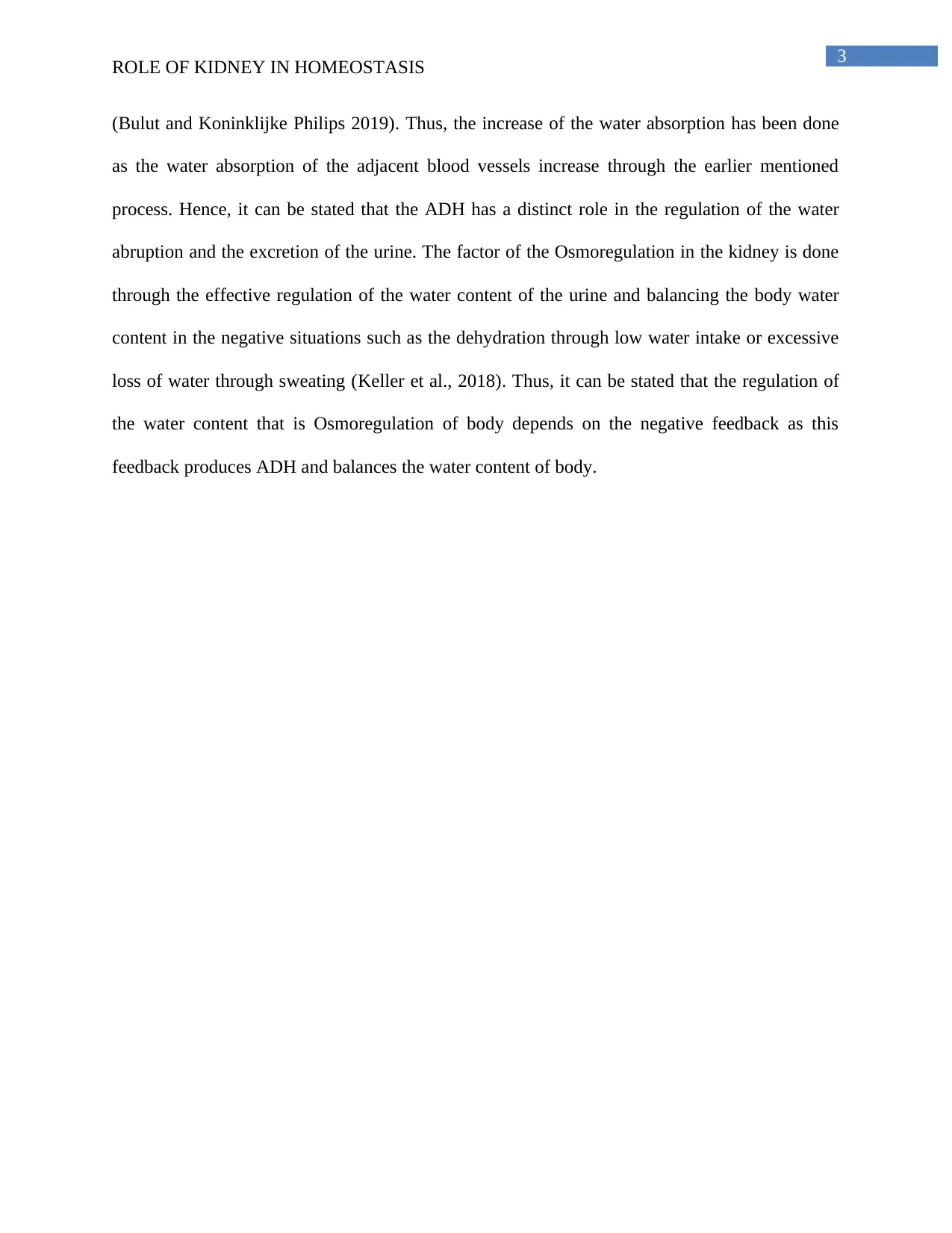
3
ROLE OF KIDNEY IN HOMEOSTASIS
(Bulut and Koninklijke Philips 2019). Thus, the increase of the water absorption has been done
as the water absorption of the adjacent blood vessels increase through the earlier mentioned
process. Hence, it can be stated that the ADH has a distinct role in the regulation of the water
abruption and the excretion of the urine. The factor of the Osmoregulation in the kidney is done
through the effective regulation of the water content of the urine and balancing the body water
content in the negative situations such as the dehydration through low water intake or excessive
loss of water through sweating (Keller et al., 2018). Thus, it can be stated that the regulation of
the water content that is Osmoregulation of body depends on the negative feedback as this
feedback produces ADH and balances the water content of body.
ROLE OF KIDNEY IN HOMEOSTASIS
(Bulut and Koninklijke Philips 2019). Thus, the increase of the water absorption has been done
as the water absorption of the adjacent blood vessels increase through the earlier mentioned
process. Hence, it can be stated that the ADH has a distinct role in the regulation of the water
abruption and the excretion of the urine. The factor of the Osmoregulation in the kidney is done
through the effective regulation of the water content of the urine and balancing the body water
content in the negative situations such as the dehydration through low water intake or excessive
loss of water through sweating (Keller et al., 2018). Thus, it can be stated that the regulation of
the water content that is Osmoregulation of body depends on the negative feedback as this
feedback produces ADH and balances the water content of body.
Paraphrase This Document
Need a fresh take? Get an instant paraphrase of this document with our AI Paraphraser
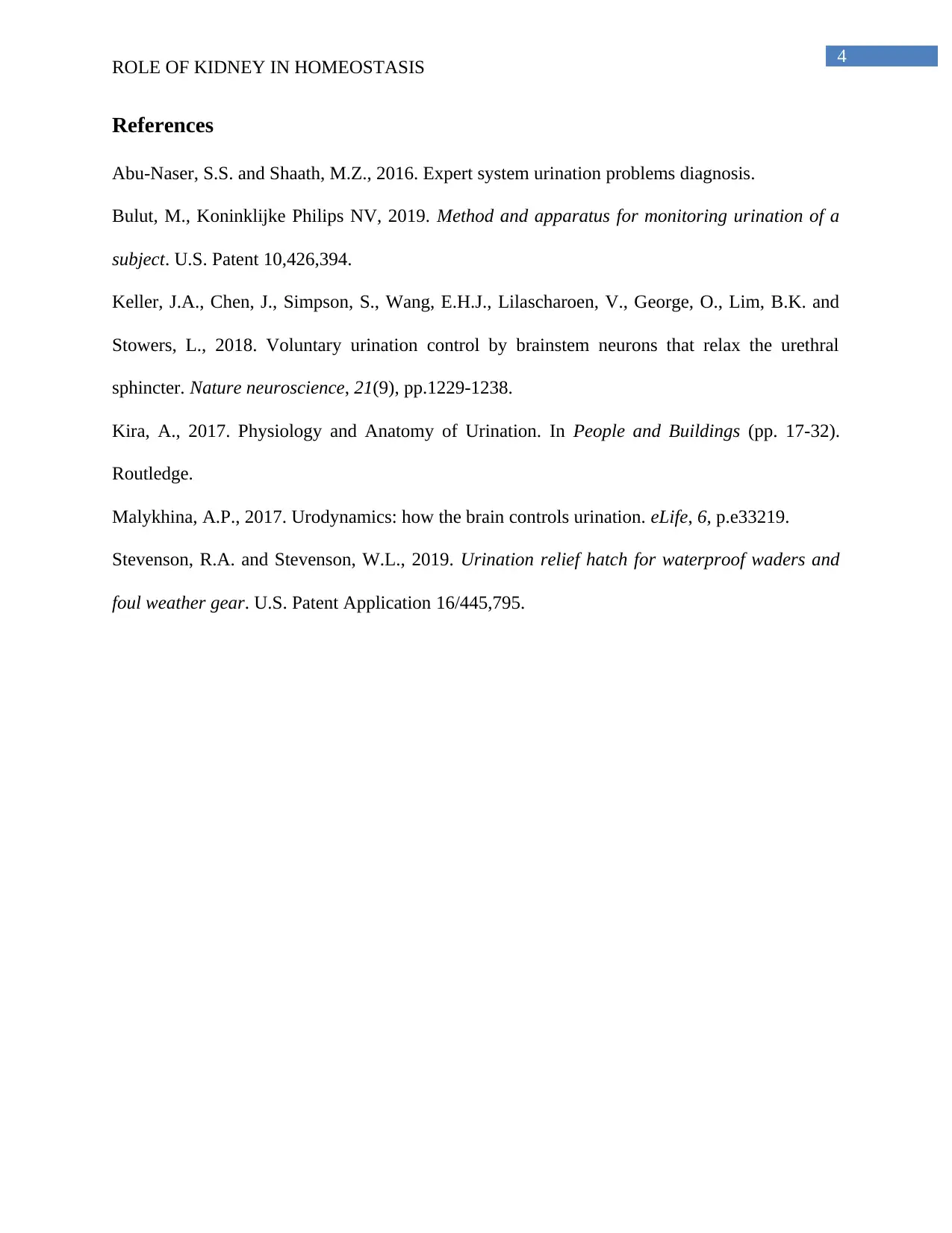
4
ROLE OF KIDNEY IN HOMEOSTASIS
References
Abu-Naser, S.S. and Shaath, M.Z., 2016. Expert system urination problems diagnosis.
Bulut, M., Koninklijke Philips NV, 2019. Method and apparatus for monitoring urination of a
subject. U.S. Patent 10,426,394.
Keller, J.A., Chen, J., Simpson, S., Wang, E.H.J., Lilascharoen, V., George, O., Lim, B.K. and
Stowers, L., 2018. Voluntary urination control by brainstem neurons that relax the urethral
sphincter. Nature neuroscience, 21(9), pp.1229-1238.
Kira, A., 2017. Physiology and Anatomy of Urination. In People and Buildings (pp. 17-32).
Routledge.
Malykhina, A.P., 2017. Urodynamics: how the brain controls urination. eLife, 6, p.e33219.
Stevenson, R.A. and Stevenson, W.L., 2019. Urination relief hatch for waterproof waders and
foul weather gear. U.S. Patent Application 16/445,795.
ROLE OF KIDNEY IN HOMEOSTASIS
References
Abu-Naser, S.S. and Shaath, M.Z., 2016. Expert system urination problems diagnosis.
Bulut, M., Koninklijke Philips NV, 2019. Method and apparatus for monitoring urination of a
subject. U.S. Patent 10,426,394.
Keller, J.A., Chen, J., Simpson, S., Wang, E.H.J., Lilascharoen, V., George, O., Lim, B.K. and
Stowers, L., 2018. Voluntary urination control by brainstem neurons that relax the urethral
sphincter. Nature neuroscience, 21(9), pp.1229-1238.
Kira, A., 2017. Physiology and Anatomy of Urination. In People and Buildings (pp. 17-32).
Routledge.
Malykhina, A.P., 2017. Urodynamics: how the brain controls urination. eLife, 6, p.e33219.
Stevenson, R.A. and Stevenson, W.L., 2019. Urination relief hatch for waterproof waders and
foul weather gear. U.S. Patent Application 16/445,795.
1 out of 5
Related Documents
Your All-in-One AI-Powered Toolkit for Academic Success.
+13062052269
info@desklib.com
Available 24*7 on WhatsApp / Email
![[object Object]](/_next/static/media/star-bottom.7253800d.svg)
Unlock your academic potential
Copyright © 2020–2025 A2Z Services. All Rights Reserved. Developed and managed by ZUCOL.





